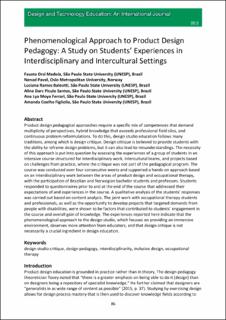| dc.contributor.author | Medola, Fausto Orsi | |
| dc.contributor.author | Pavel, Nenad | |
| dc.contributor.author | Ramos Baleotti, Luciana | |
| dc.contributor.author | Darc Piculo Santos, Aline | |
| dc.contributor.author | Moya Ferrari, Ana Lya | |
| dc.contributor.author | Coelho Figliolia, Amanda | |
| dc.date.accessioned | 2021-10-01T13:27:21Z | |
| dc.date.available | 2021-10-01T13:27:21Z | |
| dc.date.created | 2021-08-22T12:20:27Z | |
| dc.date.issued | 2021-07-01 | |
| dc.identifier.citation | Design and Technology Education: An International Journal. 2021, 26 (2), 86-100. | en_US |
| dc.identifier.issn | 1360-1431 | |
| dc.identifier.uri | https://hdl.handle.net/11250/2787069 | |
| dc.description.abstract | Product design pedagogical approaches require a specific mix of competences that demand multiplicity of perspectives, hybrid knowledge that exceeds professional field silos, and continuous problem reformulations. To do this, design studio education follows many traditions, among which is design critique. Design critique is believed to provide students with the ability to reframe design problems, but it can also lead to misunderstandings. The necessity of this approach is put into question by assessing the experiences of a group of students in an intensive course structured for interdisciplinary work, intercultural teams, and projects based on challenges from practice, where the critique was not part of the pedagogical program. The course was conducted over four consecutive weeks and supported a hands-on approach based on an interdisciplinary work between the areas of product design and occupational therapy, with the participation of Brazilian and Norwegian bachelor students and professors. Students responded to questionnaires prior to and at the end of the course that addressed their expectations of and experiences in the course. A qualitative analysis of the students’ responses was carried out based on content analysis. The joint work with occupational therapy students and professionals, as well as the opportunity to develop projects that targeted demands from people with disabilities, were shown to be factors that contributed to students’ engagement in the course and overall gain of knowledge. The experiences reported here indicate that the phenomenological approach to the design studio, which focuses on providing an immersive environment, deserves more attention from educators, and that design critique is not necessarily a crucial ingredient in design education. | en_US |
| dc.description.sponsorship | The research is financed by DIKU (Norwegian Agency for International Cooperation and Quality Enhancement in Higher Education) under grant UTF-2016-long-term/10053, and Conselho Nacional de Desenvolvimento Científico e Tecnológico – CNPq - Brasil (Process 310661/2017-0). | en_US |
| dc.language.iso | eng | en_US |
| dc.publisher | The Design and Technology Association | en_US |
| dc.relation.ispartofseries | Design and Technology Education: An International Journal;Vol 26 No 2 (2021) | |
| dc.relation.uri | https://ojs.lboro.ac.uk/DATE/article/view/2956 | |
| dc.subject | Design studio critique | en_US |
| dc.subject | Design pedagogy | en_US |
| dc.subject | Interdisciplinarity | en_US |
| dc.subject | Inclusive design | en_US |
| dc.subject | Occupational therapy | en_US |
| dc.title | Phenomenological Approach to Product Design Pedagogy: A Study on Students’ Experiences in Interdisciplinary and Intercultural Settings | en_US |
| dc.type | Academic article | en_US |
| dc.description.version | publishedVersion | en_US |
| cristin.ispublished | true | |
| cristin.fulltext | original | |
| cristin.qualitycode | 1 | |
| dc.identifier.doi | https://ojs.lboro.ac.uk/DATE/article/view/2956 | |
| dc.identifier.cristin | 1927839 | |
| dc.source.journal | Design and Technology Education: An International Journal | en_US |
| dc.source.volume | 26 | en_US |
| dc.source.issue | 2 | en_US |
| dc.source.pagenumber | 86-100 | en_US |
| dc.relation.project | Norwegian Agency for International Cooperation and Quality Enhancement in Higher Education: UTF-2016-long-term/10053 | en_US |
| dc.relation.project | Conselho Nacional de Desenvolvimento Científico e Tecnológico – CNPq - Brasil: 310661/2017-0 | en_US |
